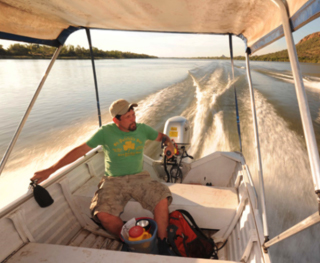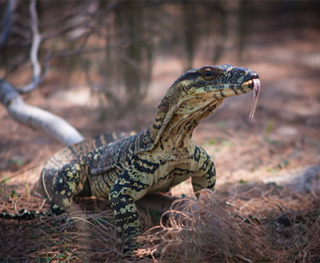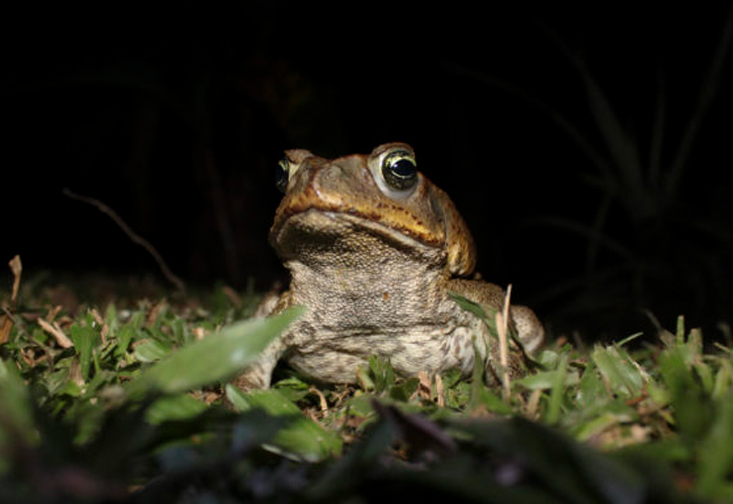In August 1935, scientists released 102 nonnative cane toads in northeastern Australia, hoping the large and voracious amphibians would help control an onslaught of pests that were ravaging Queensland’s valuable sugarcane plantations.
It didn’t take long for the scientists to realize their effort was a dud – the cane toads barely made a dent in the pests. Worse yet, the new invaders began devastating Australia’s native predatory snakes, lizards and crocodiles, causing them to die in droves after attempting to ingest the toxic toads. Populations of native reptilian predators declined by more than 90 percent in some regions as the cane toads expanded their territory west across the continent.
Now, conservation biologist Sean Doody is engaged in a research project to save one of Australia’s unique predators. Doody and Macquarie University biologist Simon Clulow are leading an effort to collect sperm from goannas, a monitor lizard that has seen a massive population crash during the cane toad invasion, and create a gene bank that could save the species from extinction. Their work is part of a wider project called the Kimberley Ark, which aims to preserve the genetics of species under threat from cane toads in northwestern Australia.

Conservation biologist Sean Doody surveys the shore for fauna while conducting field work in Australia. Photo courtesy of Sean Doody
“Australia is the only continent other than Antarctica that doesn’t have native toxic toads,” said Doody, an assistant professor at USF’s St. Petersburg campus. “Australian predator species have lost their ability to resist toad toxins.”
After their initial introduction in the 1930s, the cane toad population remained relatively dormant in Australia. Then suddenly their population ballooned. Today, it is estimated there are tens to hundreds of millions of cane toads spread across the continent. The invasive toads are also a problem in Florida, where they pose a threat to pets and native animals.
When threatened, cane toads expel a milky-white substance known as bufotoxin from their skin, which can sicken and kill animals. In Australia, cane toads have caused populations of some native predators to plummet, creating cascading effects on the animal community and resulting in a drastic loss of genetic diversity.
”Cane toads can cause regional extinctions in some species, including top predators, which can cause the whole ecological community to get out of whack,” Doody said. “At the same time, we can’t seem to control them. The scale of the problem is unbelievable and the remoteness of northern Australia makes it impossible to stop their spread or reduce their populations to any reasonable amount.”
While Australia hasn’t completely lost any species due to the cane toad invasion, the loss of genetic diversity poses an existential threat to populations. After standard control measures failed, researchers began exploring the idea of a gene bank.

Doody is leading the development of a gene bank to preserve the genetic diversity of goannas, Australia’s native monitor lizards. Credit: Paul Welding
Through the Kimberley Ark, Doody and Clulow aim to preserve genetic diversity by collecting and storing sperm in a gene bank that can later be used to reestablish stunted populations.
One of the big challenges for the project has been figuring out the best way to collect and preserve goanna sperm. In 2014, the researchers achieved an Australian first when they obtained sperm samples from lizards using a technique called electro ejaculation, which had only been successfully performed on reptiles in the United States. More invasive collection techniques, such as gathering sperm from goannas caught for food by aboriginal people in Australia, have since proved more efficient.
University of Newcastle PhD candidate Lachlan Campbell recently worked out protocols to successfully treat, freeze, and thaw sperm from field-caught animals – a major breakthrough in ensuring the gene-banked sperm remains viable and able to move properly through the female reproductive tract. The next steps involve captive rearing the goannas and conducting artificial insemination, for which Doody said additional funding is needed.
Financial support can’t come soon enough. Cane toad territory is currently expanding westward at about 18-30 miles per year, according to Doody, which means they’ll reach the northwest coast of Australia in five to ten years.
“The toads haven’t quite taken the north,” Doody said, referring to the Australian continent. “There are still 300-400 miles left. If we can get ahead of the toads and capture that genetic diversity before the toads invade those regions, we can perhaps reintroduce that diversity later.”
